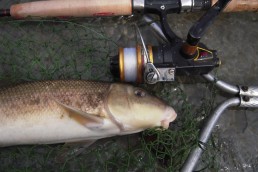Late-Fall Muskies are Suckers for Suckers
SHARE THIS POST
Old school vs. new school—Dave Csanda discusses various hooking arrangements to catch fall muskies.
Dating back 100 years or more, northern Wisconsin anglers would row-troll live suckers behind their small rowboats in late fall in search of muskies. Nose-hooked suckers were either suspended beneath a large bobber for fishing weed lines or flooded timber edges, or on weighted lines to reach deep water rimming points, bars and humps in lakes and flowages.
Old-school sucker harnesses featured heavy-gauge wire and large, beefy hooks. Back in the day, the front hook was a large, square-bend treble inserted up through the sucker’s mouth and out the top of its snout. Nowadays, it’s usually a smaller treble inserted behind the nose. In the days before rubber bands, the trailing rear treble was either somehow tied around the minnow’s body, or one hook point was inserted into the skin to hold it in place. Stiff rods and braided Dacron line were used to drive the hook home on a bite, and then to fight and land the biggest fish in the lake. Today, long muskie rods and braided lines seal the deal.
Fast forward to today, and similar tactics still produce for late-fall, cold-water muskies—with refinements, of course. Heavy-gauge wire harnesses have been replaced by much lighter wire versions. The hooks are considerably smaller and certainly sharper, yet still sturdy enough to go toe-to-toe with a fall giant.
While lakes and flowages still attract the lion’s share of anglers using this approach, rivers throughout the North Country provide often-untapped opportunities for fall giants. In fall, muskies migrate to deeper holes, usually at river bends but potentially also below bridges and dams, and where creeks enter the main river. Fishing from an anchored position and suspending a sucker below a bobber begs for a big bite—or bites.
Muskies are the biggest critters in the river, so they can be anywhere they want. But the odds are always good for drifting a bobber rig downstream along the current seam where current wraps around an eddy formed at the river bend. Sometimes, your first drift sees a panicked sucker frantically dashing, bobber in tow, until it suddenly stops, then plunges beneath the surface. Tighten up your line and slam the hook home. Then hang on tight as pandemonium ensues.
Are you enjoying this post?
You can be among the first to get the latest info on where to go, what to use and how to use it!
If muskies don’t seem to be holding along the current break, try fishing some alternate areas: like within large eddies themselves, or along the downstream bank of the outer river bend where current dissipates. Sometimes, muskies lie up shallow in relatively current-free areas adjacent to deep holes, almost like they’re sunning themselves. Who knows?
Odds-wise, however, sunny days are not the best muskie days, all else being equal. You want to be out there on cloudy, miserable days with rain, sleet or snow; toss in a brisk wind to really earn your stripes. The big brutes just seem to be more active and biting on days when only the tough and/or foolhardy dare to brave the elements.
All of this is not to say that you won’t catch a big fish or two while tossing large muskie lures for late-fall behemoths. But under the right conditions, the sucker thing really works wonders. Besides, you can munch a sandwich and drink hot coffee while seated next to an onboard heater as you watch your bobber dance in the current, rather than relentlessly flailing away with cold fingers and sore shoulders.
Fortunately, nowadays, at least you don’t have to row!
Looking for some new fishing techniques to try this season? You’ll find plenty of suggestions in every issue of MidWest Outdoors. Subscribe on our website.
MWO
SHARE THIS POST
You may also like...
Nothing found.
Did you enjoy this post?
You can be among the first to get the latest info on where to go, what to use and how to use it!
Dave Csanda
Dave Csanda has enjoyed 40 years in the fishing communications industry at In-Fisherman, Angling Edge and now, as editor of MidWest Outdoors. He is an inductee of both the Minnesota and National Fresh Water Fishing Halls of Fame.
